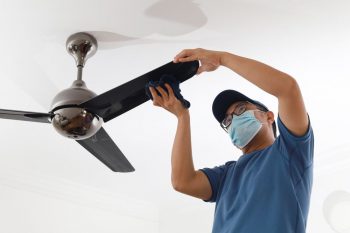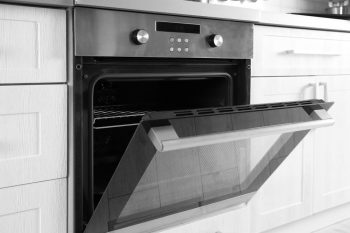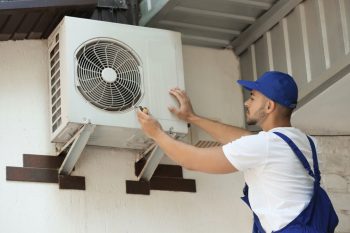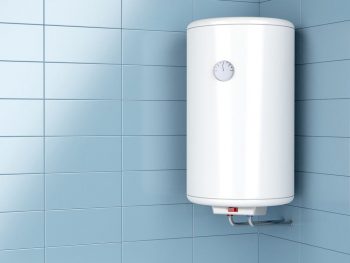
Ceiling fans are an excellent way to keep your home comfortable and your energy costs low. However, many people are unaware that the direction of a ceiling fan’s rotation should change with the seasons. In this in-depth guide, we will show you how to change the direction of a ceiling fan to counter-clockwise, a setting that is ideal for the summer months.
To change the direction of a ceiling fan to counter-clockwise, first ensure the fan is completely turned off. Then, locate the direction switch on the motor housing of the fan. Flip this switch in the opposite direction to change the fan’s rotation to counter-clockwise. For vertical direction switches, flip the switch down. For horizontal direction switches, flip the switch to the left. Turn the fan back on to ensure it’s now rotating counter-clockwise.
Why Does Fan Direction Matter?
The direction of your ceiling fan matters because it determines the direction of airflow in the room. When set to rotate counter-clockwise, the fan pushes cool air down directly below it. This creates a “wind chill” effect on your skin that makes the air feel cooler than it actually is. This allows you to set your thermostat a few degrees higher, saving on energy costs.
Tools Required
Before you get started, ensure you have these tools on hand:
- A step stool or ladder to reach the fan.
- A screwdriver, in case you need to remove any screws or panels to access the fan’s switch or button.
- The user manual or instructions for your specific ceiling fan model, if you are unsure of where the reversing switch is located.
Changing the Fan Direction to Counter Clockwise
Now, let’s get to the steps involved in changing the direction of your ceiling fan to counter-clockwise:
- Turn off the fan: Ensure the fan is completely turned off and the blades have stopped moving before you approach it.
- Locate the direction switch: Find the direction switch on the motor housing of the fan. In some cases, the switch may be located inside the switch housing or switch cup. If your fan doesn’t have a switch on the motor, the direction reverse may be handled differently, such as a button on the fan’s remote control or a hanging chain that needs to be pulled.
- Flip the switch: Once you’ve located the direction switch, flip it in the opposite direction to change the fan’s rotation to counter-clockwise. For vertical direction switches, flip the switch down for downward airflow (counter-clockwise). For horizontal direction switches, flip the switch to the left for downward airflow (counter-clockwise) .
- Turn the fan back on: After changing the direction, turn the fan back on to ensure it’s now rotating counter-clockwise. You should feel a downward breeze, which helps cool down the room.
Troubleshooting Tips
If your ceiling fan does not switch to counter-clockwise as expected, you can try the following troubleshooting tips:
- Check the wiring: Turn off the power at the source, access the motor housing, and inspect the wiring for any disconnected or loose wires. If you find any issues, contact an electrician to determine the right solution.
- Clean and lubricate the ball bearings: Locate the ball bearings and clean them. Add lubricant to ensure proper rotation.
- Replace the ceiling fan capacitor: If the fan’s multi-speed operation is erratic, consider replacing the capacitor.
- Check the ceiling fan motor: Make sure the motor isn’t getting too hot. Run the fan for about 10 minutes, then turn it off and feel the motor housing with your hand. If it feels hot, consider replacing the motor.
- Verify the blade angle: Ensure that the fan blades are angled properly, ideally at about a 15-degree angle or slightly flatter.
In conclusion, changing the direction of your ceiling fan to counter-clockwise for the summer months can help create a cooler environment and save energy. By understanding how to change the direction and troubleshoot any issues, you can ensure your ceiling fan operates optimally throughout the year.
Frequently Asked Questions
What is the ideal direction for a ceiling fan in the winter months?
During the winter months, the ideal direction for a ceiling fan is clockwise. When set to rotate clockwise, the fan pulls up the cool air from the floor and pushes the warm air down from the ceiling, helping to distribute the warm air evenly in the room.
How can I tell if my ceiling fan is rotating in a counter-clockwise direction?
Stand directly under the fan and look up. If the fan is rotating in a counter-clockwise direction, the blades should be moving from the top left, then down to the right, and then back up to the top left.
What if my ceiling fan doesn’t have a direction switch?
If your ceiling fan doesn’t have a direction switch on the motor housing, the direction reverse may be controlled differently. This could be through a button on the fan’s remote control or a chain pull switch. Refer to your fan’s user manual or instructions for specific details.
What is the purpose of a ceiling fan capacitor?
A ceiling fan capacitor is a small, black box that controls the start and stop mechanisms, as well as the fan speed. If your fan’s multi-speed operation is erratic or the fan won’t start, the capacitor may need to be replaced.
How often should I change the direction of my ceiling fan?
Generally, you should change the direction of your ceiling fan twice a year – once at the start of summer (to counter-clockwise) and once at the start of winter (to clockwise). This helps maintain optimal airflow and temperature control in your home.











